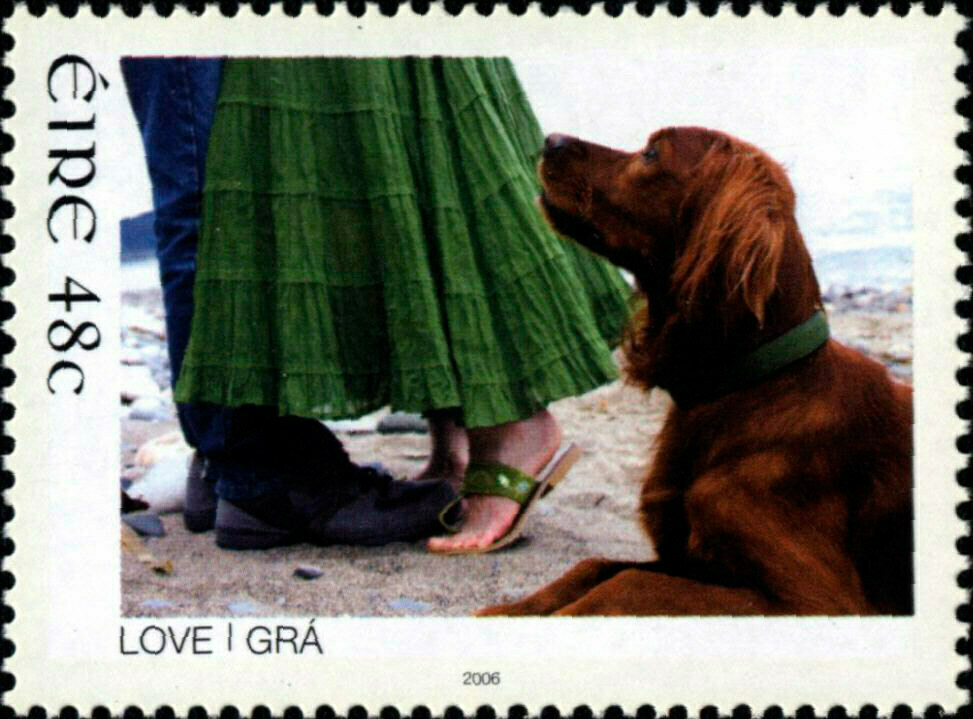In a new blog, we chat to Stephen Ferguson, assistant secretary and museum curator at An Post, about the ‘Post Office Irish Postage Stamp Collection’ on the Digital Repository of Ireland (DRI). This collection features an extensive range of stamps reflecting the development of the country, both historic and artistic, over the century since Irish independence.
About An Post Museum & Archive
An Post Museum & Archive holds artefacts and archival materials that relate to the history of the Post Office in Ireland. While the Post Office is one of the oldest and most influential institutions of State, dating back to the sixteenth century, the material held by An Post Museum & Archive is more recent and consists largely of what has survived from the nineteenth and twentieth centuries.
An Post Museum & Archive recently published the ‘Post Office Irish Postage Stamp Collection’ on the Digital Repository of Ireland (DRI). This collection features an extensive range of stamps reflecting the development of the country, both historic and artistic, over the century since Irish independence. The collection is divided into sub-collections featuring stamps from the following periods: 1922–1983; 1984–2000; 2001–2010; and 2011–2019.
In this interview, DRI Communications and Engagement Coordinator Áine Madden speaks to Stephen Ferguson, assistant secretary and museum curator at An Post Museum and Archive, about the new collection publication and its value for researchers, philatelists, and anybody interested in learning more about Ireland’s history, culture, and design through the exploration of this unique collection. Stephen shares how, as visual records of Irish life through the decades, the stamps in this collection not only provide an important historical record of cultural and social change, but also ‘open a window onto the Irish soul and reveal to us both how we see ourselves and how we would wish to be seen’.
Interview
DRI: Hello Stephen, thank you for joining us for this interview. Can you tell us a little bit about the ‘Post Office Irish Postage Stamp Collection’ and subcollections, recently published on DRI by An Post Museum & Archive?
Stephen Ferguson: Thanks very much Áine for the chance to say a little about our stamp collections here in the An Post Museum & Archive. We have a number of stamp and postal history collections which have been formed over the years. Our Irish collections contain samples of the stamps issued since independence in 1922 with, sometimes, accompanying artwork and printing proofs. The material we published recently on DRI shows individual stamps from the first overprints of 1922 right up to 2019. It is divided into four sub-collections, arranged by date, and visitors can either browse or, if they have a particular subject in mind, search for what they want. For the serious researcher or philatelist, access to a good stamp catalogue will still be useful in tracking down a particular stamp issue.
DRI: An Post Museum & Archive collections have stamps dating back to the formation of the Irish Free State in 1922, including the first stamps issued by the Post Office – British stamps of King George V, overprinted in Irish. Can you tell us more about the symbolic significance of these stamps?
Stephen Ferguson: British stamps were in everyday use in Ireland from the introduction of the world’s first adhesive stamp, the Penny Black, back in 1840. Independence in 1922 provided an opportunity to use postage stamps to highlight the political change that had occurred and the quickest and simplest way to do that was to take the existing British stamps and overprint them in Irish with the words, Rialtas Sealadach na h-Éireann 1922, or Provisional Government of Ireland 1922. The project had the agreement of the authorities in London – it may have helped that King George V was a very keen stamp collector – and the overprinting work was carried out by firms both in Dublin and London. The resulting stamps were not free from various errors – a delight for specialist stamp collectors – but they declared Irish independence to the world in a way that was both symbolic and tangible, in much the same way as the repainting of our letterboxes from red to green would do a little later on.

Image: An Post. (2021) George V British Definitive Issue – Overprinted by Thom in Shiny Blue-Black Ink, Digital Repository of Ireland [Distributor], An Post Museum and Archive [Depositing Institution], https://doi.org/10.7486/DRI.zs26b0191
DRI: The stamps in the ‘Post Office Irish Postage Stamp Collection’ offer an insight into Irish design, as well as Irish history. Is there a stamp that you feel is particularly significant, from an artistic point of view?
Stephen Ferguson: Irish stamps have provided a miniature canvas for both well-known and emerging artists over the years as well as commemorating the work of others in many different artistic fields. Changes in printing technologies also had a big impact on the way in which artistic designs could be realised. One stamp that is a favourite of mine is our 2006 Love stamp which, to my mind, succeeds by what it omits rather than by what it portrays. We simply see the feet of a man and woman, clearly embracing, and the head and shoulders of an Irish Red Setter looking up at them from below. It’s a clever idea and, by setting aside the traditional symbols and depictions of love, makes us fill in, see and understand what is not shown.

Image: An Post. (2021) Greeting Love Gra, Digital Repository of Ireland [Distributor], An Post Museum and Archive [Depositing Institution], https://doi.org/10.7486/DRI.7m01r9475
DRI: Can you tell us why you felt it was important to digitally preserve the An Post Museum & Archive stamp collections on DRI for long-term access?
Stephen Ferguson: People of my vintage will recall childhood stamp collections, sticking the stamps carefully into a special album and ‘swapping’ duplicates with other children during school breaks. It was once a very popular hobby, encouraged by parents and teachers because of its educational value, but also one which allowed children to focus on subjects that were of special interest to them – a particular country maybe, or themes like music, football, or castles on stamps. It’s no longer the hobby it once was and, with fewer and fewer people writing letters any more, it’s not uncommon for many people to have very little contact with postage stamps at all. The nature of communications has changed radically in the last generation and the world has moved on but since there is so much artistic beauty, skilful work, and symbolic significance in our Irish stamps, I thought it would be great if we could make them available for people to admire, study, and generally appreciate in digital format. DRI has made that possible, providing both a platform and lots of much-needed technical assistance and who knows, maybe we’ll see a renewed interest in stamp collecting as well!
DRI: What do you hope people can learn from exploring the ‘Post Office Irish Postage Stamp Collection’?
Stephen Ferguson: I think there’s two levels of learning here, Áine. There is the straightforward acquisition of knowledge that comes from exposure to a medium that tells us about our history, our culture, our famous people and the events and institutions that have been part of Irish life over the last century. Coupled with this is an appreciation of the stamp as an art form, a printed object, and an expression of design. At a deeper level, however, I think our stamps open a window onto the Irish soul and reveal to us both how we see ourselves and how we would wish to be seen. In comparison with our earlier issues, the subjects and people we mark on stamps now are more international and show an Ireland that is more confident and outward-looking. There are also signs, for better or worse, of a more commercial approach to stamp issuing policy, a more populist attitude perhaps. Can you imagine a Father Ted series of stamps fifty years ago? Stamps are, in a sense, archival documents and each generation will, I hope, be able to explore them and learn something new.
DRI: Thank you, Stephen, for your time today. Before we finish up, would you like to share plans for future collection publications or other An Post Museum & Archive developments?
Stephen Ferguson: Our collections are modest but because the Post Office has been closely involved in so many different aspects of Irish life, we have, I think, some interesting material. I have some posters from the early nineteenth century, Robbery Reward Notices, which highlight how often there were attacks on mail coaches and postmen throughout the country and I’d like to make some of these available. Also, with Christmas coming, I’ve been doing a little work on the Post early for Christmas posters we used to produce and this small collection would, I’m sure, bring back memories – happy I hope – of letters and parcels in the run-up to Christmas. Finally, if I can find space somewhere and perhaps a willing sponsor, I’d also like to see if I can put on a small exhibition of physical stamps and related material to mark Irish independence next year.
Explore the ‘Post Office Irish Postage Stamp Collection’: https://doi.org/10.7486/DRI.p841pb88f
Learn more about DRI Membership here: https://dri.ie/membership
Interview conducted by DRI Communications and Engagement Coordinator Áine Madden




